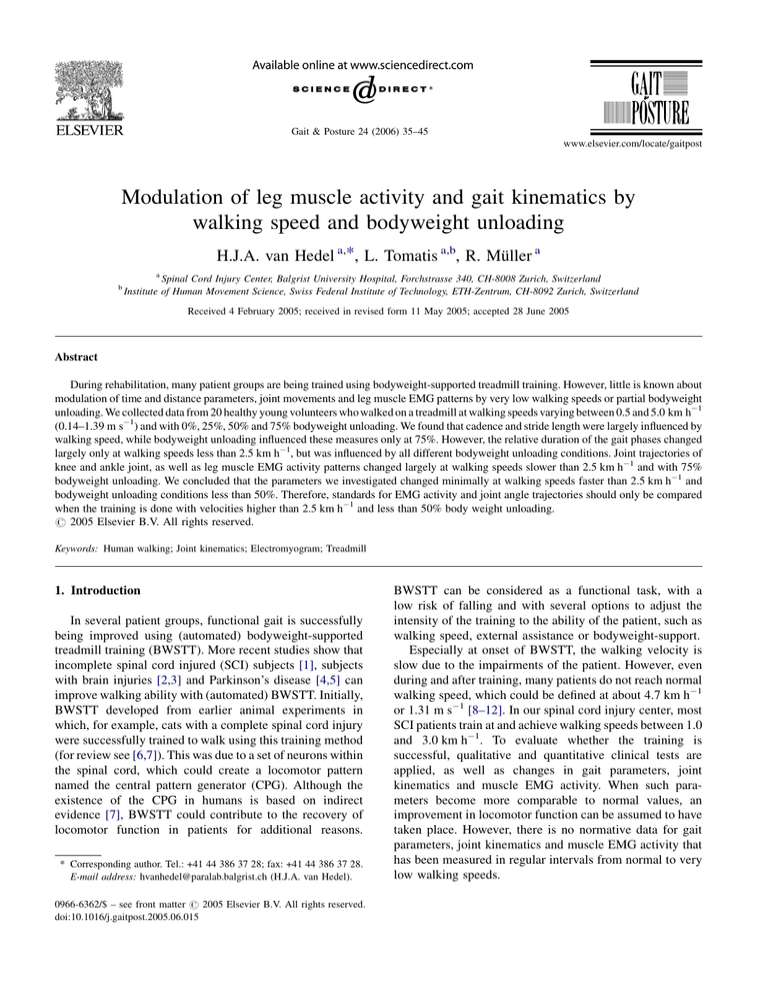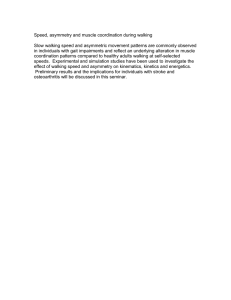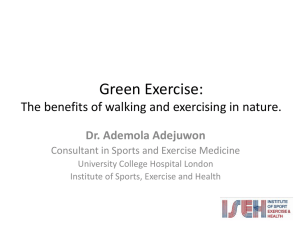
Gait & Posture 24 (2006) 35–45
www.elsevier.com/locate/gaitpost
Modulation of leg muscle activity and gait kinematics by
walking speed and bodyweight unloading
H.J.A. van Hedel a,*, L. Tomatis a,b, R. Müller a
b
a
Spinal Cord Injury Center, Balgrist University Hospital, Forchstrasse 340, CH-8008 Zurich, Switzerland
Institute of Human Movement Science, Swiss Federal Institute of Technology, ETH-Zentrum, CH-8092 Zurich, Switzerland
Received 4 February 2005; received in revised form 11 May 2005; accepted 28 June 2005
Abstract
During rehabilitation, many patient groups are being trained using bodyweight-supported treadmill training. However, little is known about
modulation of time and distance parameters, joint movements and leg muscle EMG patterns by very low walking speeds or partial bodyweight
unloading. We collected data from 20 healthy young volunteers who walked on a treadmill at walking speeds varying between 0.5 and 5.0 km h 1
(0.14–1.39 m s 1) and with 0%, 25%, 50% and 75% bodyweight unloading. We found that cadence and stride length were largely influenced by
walking speed, while bodyweight unloading influenced these measures only at 75%. However, the relative duration of the gait phases changed
largely only at walking speeds less than 2.5 km h 1, but was influenced by all different bodyweight unloading conditions. Joint trajectories of
knee and ankle joint, as well as leg muscle EMG activity patterns changed largely at walking speeds slower than 2.5 km h 1 and with 75%
bodyweight unloading. We concluded that the parameters we investigated changed minimally at walking speeds faster than 2.5 km h 1 and
bodyweight unloading conditions less than 50%. Therefore, standards for EMG activity and joint angle trajectories should only be compared
when the training is done with velocities higher than 2.5 km h 1 and less than 50% body weight unloading.
# 2005 Elsevier B.V. All rights reserved.
Keywords: Human walking; Joint kinematics; Electromyogram; Treadmill
1. Introduction
In several patient groups, functional gait is successfully
being improved using (automated) bodyweight-supported
treadmill training (BWSTT). More recent studies show that
incomplete spinal cord injured (SCI) subjects [1], subjects
with brain injuries [2,3] and Parkinson’s disease [4,5] can
improve walking ability with (automated) BWSTT. Initially,
BWSTT developed from earlier animal experiments in
which, for example, cats with a complete spinal cord injury
were successfully trained to walk using this training method
(for review see [6,7]). This was due to a set of neurons within
the spinal cord, which could create a locomotor pattern
named the central pattern generator (CPG). Although the
existence of the CPG in humans is based on indirect
evidence [7], BWSTT could contribute to the recovery of
locomotor function in patients for additional reasons.
* Corresponding author. Tel.: +41 44 386 37 28; fax: +41 44 386 37 28.
E-mail address: hvanhedel@paralab.balgrist.ch (H.J.A. van Hedel).
0966-6362/$ – see front matter # 2005 Elsevier B.V. All rights reserved.
doi:10.1016/j.gaitpost.2005.06.015
BWSTT can be considered as a functional task, with a
low risk of falling and with several options to adjust the
intensity of the training to the ability of the patient, such as
walking speed, external assistance or bodyweight-support.
Especially at onset of BWSTT, the walking velocity is
slow due to the impairments of the patient. However, even
during and after training, many patients do not reach normal
walking speed, which could be defined at about 4.7 km h 1
or 1.31 m s 1 [8–12]. In our spinal cord injury center, most
SCI patients train at and achieve walking speeds between 1.0
and 3.0 km h 1. To evaluate whether the training is
successful, qualitative and quantitative clinical tests are
applied, as well as changes in gait parameters, joint
kinematics and muscle EMG activity. When such parameters become more comparable to normal values, an
improvement in locomotor function can be assumed to have
taken place. However, there is no normative data for gait
parameters, joint kinematics and muscle EMG activity that
has been measured in regular intervals from normal to very
low walking speeds.
36
H.J.A. van Hedel et al. / Gait & Posture 24 (2006) 35–45
In addition, the influence of different amounts of
bodyweight unloading on these parameters, especially at
lower walking speeds, is unclear. Previous studies showed
that mainly extensor muscles become influenced by body
unloading [13,14]. However, in these studies only a limited
number of muscles were investigated and changes in neither
joint kinematics nor gait parameters were described. In
another study, kinematics were studied, but only at a walking
speed of 1.25 m s 1 [15].
Therefore, in the present study, we investigated changes
in gait parameters, joint kinematics and EMG patterns of
several leg muscles during (1) very slow to normal walking
speeds and (2) various amounts of bodyweight unloading.
The goals were to provide insight into the changes in
these parameters due to differences in walking speed and
bodyweight unloading and to provide a normative data set of
the parameters, which might serve as a reference for future
research and rehabilitation related studies. Finally, the
clinical significance of the results will be discussed.
2. Methods
2.1. Subjects
Twenty subjects were selected from a convenience
sample (mainly students). The 10 males and 10 females had
an average age of 23.8 3.4 (S.D.) years (range: 19–32),
were 1.74 0.07 m tall (range: 1.60–1.80) and their weight
accounted to 67.9 9.5 kg (range: 50–86). The subjects
had no known cardio-vascular, neurological or orthopedic
diagnoses and were naı̈ve to the purpose of the study. The
study was approved by the local ethic committee and the
subjects were informed and gave written consent.
2.2. Measurement protocol
One goal was to determine differences in EMG activity and
joint kinematics due to different walking speeds. Therefore,
we measured the subjects walking at speeds starting at
0.5 km h 1 (=0.14 m s 1). After the subjects became familiarized with walking at the selected speed, we recorded 25 gait
cycles. We increased the speed with steps of 0.5 km h 1 and
repeated the recording protocol until the final measurement
was performed at a speed of 5.0 km h 1 (=1.39 m s 1).
Another goal was to investigate differences in EMG
activity and joint and gait kinematics due to body unloading.
The subjects walked on the treadmill at three different
speeds (1.5, 2.0 and 2.5 km h 1 or 0.42, 0.56 and
0.69 m s 1) wearing a harness that did not interfere with
the normal gait pattern, when no bodyweight unloading was
applied (Fig. 1). The harness was connected to counter
weights, which were used to partially unload the bodyweight. We investigated the influence of bodyweight
unloading at 0%, 25%, 50% and 75% of the total
bodyweight, starting with the 0% bodyweight unloading
Fig. 1. Experimental set-up. All subjects walked on a treadmill under which
force sensors were located. To investigate differences in muscle activity and
kinematics due to bodyweight unloading, subjects wore a harness that was
connected to counter weights.
condition. After familiarization to the bodyweight unloading
condition, 25 gait cycles were measured at 1.5 km h 1, after
which we repeated the same procedure at the two higher
walking speeds. This whole procedure was repeated for
25%, 50% and 75% body unloading conditions. There was
no large break in-between the several measurements.
2.3. Recording of the measurements
The vertical forces, which were measured by onedimensional force sensors that were located under the splitbelt treadmill (Fig. 1), were used to determine the different
phases of the gait cycle. EMG and joint movement data were
all collected from the right leg. We recorded the EMG
signals of eight leg muscles using surface electrodes. The
skin was shaved and peeled to reduce skin resistance. Two
electrodes (diameter 8 mm) were placed 2.5 cm from each
other in parallel to the muscle fibers. The recorded muscles
were: gluteus maximus (GL), rectus femoris (RF), vastus
medialis (VM), vastus lateralis (VL), lateral hamstrings
(HL), medial hamstrings (HM), tibialis anterior (TA) and the
gastrocnemius medialis (GM). The EMG signals were
amplified, band-pass filtered (30–300 Hz) and transferred
together with the biomechanical signals to a PC using
SOLEASY software (ALEA Solutions GmbH, Zurich,
Switzerland) via a 12 bit AD converter. Furthermore, we
measured the joint movement trajectories using electrogoniometers (Biometrics Ltd., Gwent, UK), which were
fixated at the lateral side of the hip, knee and ankle joint. All
data were sampled at 1000 Hz.
H.J.A. van Hedel et al. / Gait & Posture 24 (2006) 35–45
2.4. Data analysis
The EMG signals were rectified and filtered using a
median-filter (25 ms). We used this filter for its good ability to
remove signal artifacts and to prevent temporal shifting of the
EMG signal. Using the forces on the treadmill, initial foot
contact of the left and right foot was determined and the data
series were cut into separate gait cycles. The start was defined
at initial foot contact of the right foot. We normalized each of
the 25 gait cycles to 1000 points and averaged these curves for
each muscle and joint. In addition, the EMG signals were
normalized for each subject and each condition by setting the
difference between the lowest and highest EMG amplitude at
100% and normalizing the curve according to this value. Due
to this, we could analyze the course of the EMG patterns well,
but not the EMG amplitude. Previous studies showed that
EMG amplitude increases by increased loading [13] or
walking speed [16]. Although, usually, EMG amplitude
normalization is done for one condition (for example peak
EMG amplitude at maximum walking speed), we normalized
for each condition to prevent that fine changes in EMG
patterns became masked by the large influence of for example
walking speed on EMG amplitude (see [16]). Finally, we
calculated the averaged curve for each muscle and joint using
the data of all 20 subjects. Furthermore, we calculated the
cadence; stride length and the changes in the percentages of
swing phase duration (SW), first and second double stance
duration (DSD1 and DSD2, respectively) and the single stance
duration (SS). We normalized the stride length by stature [17].
We calculated Pearson’s correlation coefficient (r) to quantify
the linear relationship between the cadences and normalized
stride lengths for the increase in walking speed. In addition, r
was calculated for the joint trajectories and EMG patterns
between the 5.0 km h 1 condition versus the other speeds and
between the 0% bodyweight unloading conditions versus the
other unloading conditions at 2.0 km h 1. For the EMG
patterns, the correlation coefficient depended not on the
normalization method, since r is scale-independent.
Finally, we analyzed the parameters for statistical
differences using analysis of variance (ANOVA) for
repeated measures with subsequent Bonferroni’s correction
for pair-wise comparisons. To analyze differences caused by
walking speed, a one-way ANOVA for repeated measures
was used (10 levels). To analyze differences due to body
unloading, we used a two-way ANOVA for repeated
measures (bodyweight unloading with four levels, walking
speed with three levels) and their interaction; a was set at
0.05.
37
3.1.1. Time and distance parameters
The influence of walking speed on the cadence, stride
length and the different phases of the walking cycle are
presented in Fig. 2. Both the cadence (Fig. 2A) and
normalized stride length (Fig. 2B) increased when the
walking speed increased and the variability, reflected in the
standard deviation, decreased at higher walking speed. The
cadence was significantly affected by walking speed [F(9,
171) = 613.6; P < 0.001]. Pair-wise comparisons showed
that the difference was just not significant between 4.5 and
5.0 km h 1 (P = 0.08) and significant between all other
speeds (between 4.0 and 4.5 km h 1: P = 0.048; between
3.5 and 4.0 km h 1: P = 0.002; for all other comparisons:
P < 0.001). The normalized stride length was also significantly affected by walking speed [F(9, 171) = 767.5;
P < 0.001). Pair-wise comparisons showed that the stride
length differed between each successive speed (for all:
P < 0.001). The Pearson’s correlation coefficient, calculated
between the averaged cadence and stride length for the
different walking speeds was 0.995.
With increasing speed, the relative swing phase duration
and single stance duration increased, while the relative
duration of the first and second double stance decreased
(Fig. 2C). All four measures became affected by walking
speed (for all: P < 0.001). For walking speeds less than
3. Results
3.1. The influence of walking speed
These tests were performed at speeds varying between
0.5 and 5.0 km h 1, in successive steps of 0.5 km h 1.
Fig. 2. Influence of walking speed on time and distance parameters. The
influence of walking speed on (A) cadence, (B) normalized stride length and
(C) the percentage of gait phases. Abbreviations: DSD1, first double support
duration; SS, single stance duration; DSD2, second double support duration;
SW, swing phase duration. *P < 0.05; **P < 0.01; ***P < 0.001.
38
H.J.A. van Hedel et al. / Gait & Posture 24 (2006) 35–45
2.0 km h 1, pair-wise comparisons showed that DSD1 and
DSD2 decreased and SS and SW increased significantly
between successive walking speeds with P < 0.001. Between
2.0 and 2.5 km h 1, an increase in SW (P = 0.003) and SS
(P < 0.001) occurred, while DSD1 and DSD2 decreased (for
both: P < 0.001). Finally, a slight but significant increase in
DSD2 occurred between 2.5 and 3.0 km h 1 (P = 0.045).
Remarkably, the relative swing phase duration at a walking
speed of 0.5 km h 1 was less than 20% of the gait cycle and
increased towards almost 40% at higher walking speeds.
3.1.2. Joint kinematics
Changes in joint kinematics due to different walking
speeds are shown in Fig. 3. Table 1 shows the correlation
coefficients calculated between the joint trajectories
recorded during the several walking speeds and the
trajectory at a walking speed of 5.0 km h 1. Although the
amplitude of the hip joint movement clearly increased as
walking speed increased (Fig. 3A), there were no large
differences in movement pattern, except at very slow
walking speeds. A similar finding was found for the knee
joint (Fig. 3B, Table 1). Clear changes in amplitude and
movement pattern occurred in the ankle joint (Fig. 3C,
Table 1), already at speeds slower than 3.0 km h 1.
3.1.3. Leg muscle EMG activity
Fig. 4 shows the changes in muscle activity due to
changes in walking speed. Table 1 shows the correlation
coefficients calculated between the leg muscle EMG activity
patterns recorded during the several walking speeds and the
EMG pattern at a walking speed of 5.0 km h 1. In general,
the EMG patterns of all muscles became less similar with the
pattern recorded at a walking speed of 5.0 km h 1, as the
walking speed decreased. The largest differences occurred
between 2.0 and 2.5 km h 1 for most muscles (Table 1).
Fig. 5 shows the mean trajectories one standard deviation
of the TA muscle. This should provide some insight into the
variability of the muscle EMG pattern, which decreased as
walking speed increased.
Fig. 3. Influence of walking speed on joint trajectories. Joint trajectories of
the (A) hip, (B) knee and (C) ankle joint at 10 different walking speeds.
3.2. The influence of bodyweight unloading
Four conditions of bodyweight unloading (0%, 25%, 50%
and 75%) were tested during three walking speeds (1.5, 2.0
and 2.5 km h 1). It was difficult for the subjects to walk with
75% bodyweight unloading. Some of the subjects had to
walk on their forefeet, to keep in contact with the treadmill.
3.2.1. Time and distance parameters
There appear to be no large differences in cadence or
stride length due to different amounts of bodyweight
unloading (Fig. 6). However, ANOVA for repeated measures
found that the cadence was significantly affected by
bodyweight unloading [F(3, 57) = 7.6; P < 0.001], walking
speed [F(2, 38) = 190.7; P < 0.001] and their interaction
[F(6, 114) = 4.7; P < 0.001]. Pair-wise comparisons
showed that the cadence differed in the 75% bodyweight
unloading condition from the 0% (P = 0.015), 25%
(P = 0.002) and 50% (P < 0.001) conditions. The normalized stride length was also affected by bodyweight
unloading [F(3, 57) = 11.4; P < 0.001], walking speed
[F(2, 38) = 454.0; P < 0.001] and their interaction [F(6,
114) = 4.3; P < 0.001]. Again, the stride length in the 75%
bodyweight unloading condition differed from the other
conditions (for all: P < 0.001).
Both the relative swing phase and single stance duration
increased, with an increase in bodyweight unloading, while
the duration of the double support decreased. All four
measures became significantly affected by bodyweight
unloading, speed and their interaction (for all: P < 0.001).
Pair-wise comparisons showed that these measures differed
H.J.A. van Hedel et al. / Gait & Posture 24 (2006) 35–45
39
Table 1
Linear relation of kinematics and EMG patterns between different walking speeds
Measure
Hip
Knee
Ankle
GL
RF
VL
VM
HL
HM
TA
GM
Speed
0.5
1.0
1.5
2.0
2.5
3.0
3.5
4.0
4.5
0.824
0.579
0.410
0.121
0.599
0.806
0.631
0.607
0.080
0.319
0.720
0.920
0.824
0.450
0.457
0.648
0.784
0.676
0.733
0.212
0.580
0.713
0.962
0.927
0.600
0.689
0.764
0.853
0.840
0.675
0.496
0.791
0.773
0.979
0.964
0.695
0.838
0.842
0.902
0.910
0.840
0.772
0.873
0.856
0.986
0.981
0.789
0.895
0.897
0.946
0.942
0.905
0.844
0.924
0.936
0.993
0.984
0.852
0.944
0.902
0.958
0.948
0.957
0.949
0.939
0.949
0.995
0.989
0.927
0.969
0.955
0.980
0.976
0.986
0.976
0.966
0.989
0.998
0.995
0.959
0.984
0.982
0.990
0.987
0.994
0.993
0.988
0.993
0.999
0.998
0.992
0.984
0.996
0.997
0.994
0.997
0.997
0.995
0.997
All correlation coefficients are calculated between the reference condition (5.0 km h 1) and the presented conditions. Abbreviations: GL, gluteus maximus; RF,
rectus femoris; VL, vastus lateralis; VM, vastus medialis; HL, lateral hamstrings; HM, medial hamstrings; TA, tibialis anterior and GM, gastrocnemius medialis.
between each bodyweight unloading condition (for DSD1 in
25–50%: P = 0.004; SW in 25–50%: P = 0.006; for all other
comparisons: P < 0.001).
3.2.2. Joint kinematics
Fig. 7 shows the influence of bodyweight unloading
on the joint trajectories, recorded at a walking speed of
2.0 km h 1. Table 2 shows the correlation coefficients
calculated between the joint trajectories recorded during the
several bodyweight unloading conditions and 0% bodyweight unloading. Although the r of the hip joint remained
high during the three bodyweight unloading conditions
(Table 2), the maximal extension decreased during the 50%
and 75% bodyweight unloading condition (Fig. 7A). The r
of the knee joint was considerably lower during the 75%
bodyweight unloading condition (Table 2). Indeed, in this
condition, the knee joint trajectory seemed to be shifted
leftwards during the gait cycle (Fig. 7B). The ankle joint
trajectory became also largely changed at 75% bodyweight
unloading, which is reflected in the low r (Table 2) and can
be visually inspected (Fig. 7C).
3.2.3. Leg muscle EMG activity
Fig. 8 shows the differences in muscle activity patterns
recorded at a walking speed of 2.0 km h 1 of several
bodyweight unloading conditions. Table 2 shows the
correlation coefficients calculated between the leg muscle
EMG patterns recorded during the several bodyweight
unloading conditions and 0% bodyweight unloading. The
GL muscle (Fig. 8A) showed some changes during all
bodyweight unloading conditions compared to 0% bodyweight unloading (Fig. 8A and Table 2). The EMG pattern of
the RF muscle (Fig. 8B) became clearly influenced by 75%
bodyweight unloading (Table 2), but not so much in the other
bodyweight unloading conditions. This could also be
observed for the VL (Fig. 8C and Table 2), while the
EMG pattern of the VM muscle (Fig. 8D) was more
influenced by 75% and 50% bodyweight unloading. The
largest differences were observed for the HL EMG patterns
(Fig. 8E, Table 2), where the 50% and 75% body weight
unloading conditions differed largely from the 0% condition. Similar findings were shown for the HM muscles
(Fig. 8F), although less strong than for the HL muscle. The
TA muscle (Fig. 8G) appeared to be only slightly influenced
by bodyweight unloading (Table 2), while in contrast the
EMG pattern of the GM muscle (Fig. 8H) was more strongly
influenced by the amount of bodyweight unloading, mainly
at 75% unloading (Table 2).
4. Discussion
The main results were as follows: (1) Cadence and stride
length are largely influenced by walking speed, while
bodyweight unloading influences these measures only at
75% unloading. (2) The relative duration of the gait phases
changes largely at walking speeds less than 2.5 km h 1 and
is influenced by all different bodyweight unloading
conditions. (3) Joint trajectories of knee and ankle joint,
as well as leg muscle EMG activity patterns change largely
at walking speeds slower than 2.5 km h 1 and 75%
bodyweight unloading. (4) Low walking speed seems to
increase the variability of leg muscle EMG activity between
subjects.
With increasing velocity, the product of cadence and
stride length increases [18,19]. This occurs approximately
linearly, as the high correlation coefficient shows. The
reduced significance of the difference in cadence at high
walking speeds can be explained by the decreased relative
change in walking speed. The variability of the cadence and
stride length between the subjects decreases as the speed
increases, which indicates a more consistent walking
pattern. Bodyweight unloading appears to have less impact
on the cadence and stride length. Although in the 75%
bodyweight unloading condition statistically significant
differences are found for both parameters, the differences
are so small that they might not be of any clinical
significance.
40
H.J.A. van Hedel et al. / Gait & Posture 24 (2006) 35–45
Fig. 4. Influence of walking speed on EMG activity patterns. EMG activity patterns during different walking speeds of the (A) gluteus maximus (GL), (B) rectus
femoris (RF), (C) vastus lateralis (VL), (D) vastus medialis (VM), (E) lateral hamstrings (HL), (F) medial hamstrings (HM), (G) tibialis anterior (TA) and (H)
gastrocnemius medialis (GM) muscles.
H.J.A. van Hedel et al. / Gait & Posture 24 (2006) 35–45
41
Fig. 5. Influence of walking speed on the variability in TA EMG activity. Shown are the mean and S.D. of the tibialis anterior EMG activity during
walking speeds varying between (A) 0.5 and (J) 5.0 km h 1. S.D.m is the mean standard deviation of the 1000 S.D. that were calculated for each sample
points.
The changes in the relative timing of the different gait
phases during the gait cycle are strongly influenced by
walking speed and bodyweight unloading. Walking speeds
below 2.5 km h 1 influence the relative timing of the gait
phases considerably. Since joint kinematics and muscle
EMG patterns are closely related to the gait phase, both
parameters will change considerably at lower walking
speeds, as the present results show.
Many changes in muscle EMG patterns occur at walking
speeds slower than 2.5 km h 1. While one study did not
investigate such slow walking speeds [20], another study
investigated walking speeds slower than 1.0 km h 1, but
excluded the gap between 1.0 and 3.0 km h 1 [16], which is
exactly the range of speeds achieved by our SCI patients.
Indeed, many changes in leg muscle activity patterns can be
explained by the change in relative duration of the gait
phases. At 0.5 km h 1, the stance phase accounts for over
80% of the gait cycle. This influences the joint trajectories
and leg muscle activity patterns, which are normalized for
time, considerably. Since extensor muscles are mainly active
42
H.J.A. van Hedel et al. / Gait & Posture 24 (2006) 35–45
Fig. 6. Influence of bodyweight unloading on time and distance parameters.
The influence of 0%, 25%, 50% and 75% bodyweight unloading on (A)
cadence, (B) normalized stride length and (C) the percentage of gait phases
during three walking speeds (1.5, 2.0 and 2.5 km h 1). Abbreviations:
DSD1, first double support duration; SS, single stance duration; DSD2,
second double support duration; SW, swing phase duration. *P < 0.05;
**
P < 0.01; ***P < 0.001.
Table 2
Linear relation of kinematics and EMG patterns between different bodyweight unloading conditions
Measure
Speed
25%
50%
Hip
Knee
Ankle
GL
RF
VL
VM
HL
HM
TA
GM
0.997
0.988
0.990
0.845
0.977
0.987
0.955
0.966
0.921
0.880
0.981
0.977
0.938
0.916
0.797
0.948
0.947
0.875
0.638
0.888
0.915
0.962
75%
0.939
0.776
0.427
0.864
0.851
0.888
0.684
0.029
0.457
0.903
0.783
All correlation coefficients are calculated between the reference condition
(0% bodyweight unloading) and the presented conditions. Abbreviations:
GL, gluteus maximus; RF, rectus femoris; VL, vastus lateralis; VM, vastus
medialis; HL, lateral hamstrings; HM, medial hamstrings; TA, tibialis
anterior and GM, gastrocnemius medialis.
Fig. 7. Influence of bodyweight unloading on joint trajectories. Joint
trajectories of the (A) hip, (B) knee and (C) ankle joints at 2.0 km h 1
during four different bodyweight unloading conditions (0%, 25%, 50% and
75%). Note the difference in calibrations of the y-axis.
during stance, the activity of GL, RF, VL, VM and GM
lasted longer during the gait cycle at slow speeds. In
addition, activation of flexor muscles (HL, TA and especially
HM) lasted longer during the stance phase at low walking
speeds. Although not quantified, this has to result in an
increased co-contraction of flexor and extensor muscles.
Previous studies [13,14] showed that muscle EMG
activity differed strongly between different bodyweight
unloading conditions. Similar to these studies, the EMG
activity pattern of TA, a flexor muscle, was much less
influenced than GM, an extensor muscle. However, we could
not generalize this result to more proximal muscles. The
EMG activity patterns of HL and HM were strongly
influenced by bodyweight unloading, in contrast to VL and
VM, which were less influenced. This difference could be
explained by the different parameters investigated. Previous
H.J.A. van Hedel et al. / Gait & Posture 24 (2006) 35–45
43
Fig. 8. Influence of bodyweight unloading on EMG activity patterns. EMG activity patterns during different bodyweight unloading conditions (0%, 25%,
50% and 75%) of the (A) gluteus maximus (GL), (B) rectus femoris (RF), (C) vastus lateralis (VL), (D) vastus medialis (VM), (E) lateral hamstrings (HL), (F)
medial hamstrings (HM), (G) tibialis anterior (TA) and (H) gastrocnemius medialis (GM) muscles during 2.0 km h 1. Note the difference in calibrations of
the y-axis.
44
H.J.A. van Hedel et al. / Gait & Posture 24 (2006) 35–45
studies evaluated mainly the EMG amplitude to quantify
load dependency in leg muscle activation, while we analyzed
the EMG pattern of the curve. Due to the normalization
method, we are unable to make any conclusions about
changes in EMG amplitude.
4.1. Methodological considerations
An important question is whether the present results could
also be applied to walking over ground, since some patients
can walk over ground, but at a slow walking speed. In
addition, new devices allow patients to walk over ground with
partial bodyweight unloading. There are some differences
between treadmill and over ground walking. During treadmill
walking, increases in hip range of motion, maximum hip
flexion joint angle and cadence occur, while the stance time
decreases [21]. Knee kinematics appear to be comparable
[22], while vertical ground reaction forces show similar
patterns, but differ slightly in force magnitude during midand late stance [23]. Leg muscle EMG activity is somewhat
smaller in over ground versus treadmill walking [24,25]. In
these studies, the authors observed no large differences in
timing of EMG bursts, except for the hamstrings. Activity of
the hamstrings occurred earlier at onset of the stance phase
during treadmill walking [24] and especially at slow walking
speeds [25]. We expect that some parameters (knee kinematics, most leg muscle activity patterns) that we investigated
in our study might be generalized to slow or partially
bodyweight unloaded over ground walking. However, future
research will need to address this question more accurately.
Furthermore, we measured only young healthy subjects
in these experiments. How well this data can be applied to
elderly subjects remains questionable. Some differences in
gait parameters, joint kinematics and EMG patterns have
been described between young and elderly subjects [26], as
well as differences in load dependency [13]. Therefore,
investigating gait parameters, joint kinematics and muscle
EMG patterns in a sample of healthy elderly subjects would
be interesting for a future study, since many gait impairing
disorders occur in the elderly.
4.2. Clinical relevance
We present a clinical example of a male subject (age: 26
years, stature: 1.75 m, weight: 59 kg), who acquired a
traumatic incomplete SCI at cervical 5. Initially, he was
unable to stand or walk. After 3 weeks, he started with
BWSTT. Six weeks after SCI, he was able to walk on the
treadmill without bodyweight support, but only at very slow
speed (maximum 1.5 km h 1). Fig. 9 shows the ‘normal’ TA
activity patterns recorded at walking speeds of 1.5 km h 1
(TA1.5) and 5.0 km h 1 (TA5.0) from our database and the
TA EMG patterns of the SCI patient, all recorded at
1.5 km h 1, at 6 weeks (SCI06), 15 weeks (SCI15) and 23
weeks (SCI23) after SCI. He finished his rehabilitation 24
weeks after SCI.
Fig. 9. TA EMG during recovery after incomplete spinal cord injury.
Normal EMG activity patterns at 1.5 km h 1 (TA1.5) and 5.0 km h 1
(TA5.0) and TA EMG activity patterns of the incomplete spinal cord injured
patient, all recorded at 1.5 km h 1, at 6 weeks (SCI06), 15 weeks (SCI15)
and 23 (SCI23) weeks after the injury.
Six weeks after injury, his TA EMG pattern correlated
only moderately (r = 0.57) with the TA5.0, but well with the
TA1.5 (r = 0.82; Fig. 9). As the SCI patient recovered over
time, his TA EMG pattern became more similar with TA1.5
(after 15 weeks: r = 0.90; after 23 weeks: r = 0.92). These
small improvements in TA EMG pattern occurred in parallel
to improvements in over ground walking capacity measured
with timed walking tests [27]. Six weeks after injury, he
walked 10 m in 42 s and 145 m within 6 min at preferred
walking speed. Fifteen weeks after SCI, he walked 10 m in
8 s and 445 m within 6 min, which implies normal walking
speed. While his TA EMG pattern, recorded at 1.5 km h 1,
resembled TA1.5 well, it still correlated only moderately
with TA5.0 (r = 0.68). The correlation with TA5.0 did not
further improve after 23 weeks (r = 0.61).
This example shows that although he was initially unable
to walk at normal walking speed, his TA activity pattern
resembled the normal TA activity pattern recorded at
1.5 km h 1 well. However, his TA activity pattern differed
largely from normal when compared to the TA pattern at
5.0 km h 1, which substantiates the importance of a speedadjusted database. Furthermore, improvement in over
ground walking capacity appeared to occur in parallel to
an improvement in similarity between the TA EMG patterns
recorded at similar walking speed, which might validate the
assumption that an improved EMG pattern could have a
functional significance.
We suggest that BWSTT should preferably be performed
at a minimal walking speed of 2.5 km h 1 and with
bodyweight unloading less than 75%, since this resembles
closely the normal walking pattern. Practically however, this
might be too intensive for many patients. For example, SCI
patients who exhibit poor voluntary control and additional
spasticity at the onset of their rehabilitation program will be
unable to train at such conditions, even with adequate
support of physical therapists or robotic devices. For these
patients, the slow walking speed or high bodyweight
unloading will result in somewhat different gait parameters,
joint kinematics and muscle activity patterns, which might
H.J.A. van Hedel et al. / Gait & Posture 24 (2006) 35–45
slow down the rate of functional recovery. However, even at
slow walking speeds, BWSTT can positively affect other
components of locomotor function. It resembles the
functional task of walking well and remains a relative safe
and easily controllable training tool for physical therapists.
Acknowledgements
This work was supported by the National Center for
Competence in Research on Neural Plasticity and Repair.
We thank R. Jurd for her English corrections.
References
[1] Wirz M, Zemon DH, Rupp R, Scheel A, Colombo G, Dietz V, et al.
Effectiveness of an automated locomotor training in patients with a
chronic incomplete spinal cord injury: a multicenter trial. Arch Phys
Med Rehabil 2005;86:672–80.
[2] Eich HJ, Mach H, Werner C, Hesse S. Aerobic treadmill plus Bobath
walking training improves walking in subacute stroke: a randomized
controlled trial. Clin Rehabil 2004;18:640–51.
[3] Hesse S. Recovery of gait and other motor functions after stroke: novel
physical and pharmacological treatment strategies. Restor Neurol
Neurosci 2004;22:359–69.
[4] Miyai I, Fujimoto Y, Ueda Y, Yamamoto H, Nozaki S, Saito T, et al.
Treadmill training with body weight support: its effect on Parkinson’s
disease. Arch Phys Med Rehabil 2000;81:849–52.
[5] Miyai I, Fujimoto Y, Yamamoto H, Ueda Y, Saito T, Nozaki S, et al.
Long-term effect of body weight-supported treadmill training in
Parkinson’s disease: a randomized controlled trial. Arch Phys Med
Rehabil 2002;83:1370–3.
[6] Duysens J, Van de Crommert HW. Neural control of locomotion; the
central pattern generator from cats to humans. Gait Posture 1998;
7:131–41.
[7] Van de Crommert HW, Mulder T, Duysens J. Neural control of
locomotion: sensory control of the central pattern generator and its
relation to treadmill training. Gait Posture 1998;7:251–63.
[8] Bohannon RW. Comfortable and maximum walking speed of adults
aged 20–79 years: reference values and determinants. Age Ageing
1997;26:15–9.
[9] Dean CM, Richards CL, Malouin F. Walking speed over 10 m overestimates locomotor capacity after stroke. Clin Rehabil 2001;15:
415–21.
45
[10] Perry J. Gait analysis: normal and pathological function. Thorofare:
Slack Incorporated, 1992.
[11] Steffen TM, Hacker TA, Mollinger L. Age- and gender-related test
performance in community-dwelling elderly people: 6 min walk test,
berg balance scale, timed up and go test, and gait speeds. Phys Ther
2002;82:128–37.
[12] Zijlstra W. Assessment of spatio-temporal parameters during unconstrained walking. Eur J Appl Physiol 2004;92:39–44.
[13] Dietz V, Colombo G. Influence of body load on the gait pattern in
Parkinson’s disease. Mov Disord 1998;13:255–61.
[14] Dietz V, Leenders KL, Colombo G. Leg muscle activation during gait
in Parkinson’s disease: influence of body unloading. Electroencephalogr Clin Neurophysiol 1997;105:400–5.
[15] Threlkeld AJ, Cooper LD, Monger BP, Craven AN, Haupt HG.
Temporospatial and kinematic gait alterations during treadmill walking with body weight suspension. Gait Posture 2003;17:235–45.
[16] Den Otter AR, Geurts ACH. Mulder T, Duysens J. Speed related
changes in muscle activity from normal to very slow walking speeds.
Gait Posture 2004;19:270–8.
[17] Hof AL. Scaling gait data to body size. Gait Posture 1996;4:222–3.
[18] Murray MP, Mollinger LA, Gardner GM, Sepic SB. Kinematic and
EMG patterns during slow, free, and fast walking. J Orthop Res
1984;2:272–80.
[19] Shiavi R, Champion S, Freeman F, Griffin P. Variability of electromyographic patterns for level-surface walking through a range of selfselected speeds. Bull Prosthet Res 1981;10–35:5–14.
[20] Hof AL, Elzinga H, Grimmius W, Halbertsma JP. Speed dependence
of averaged EMG profiles in walking. Gait Posture 2002;16:78–86.
[21] Alton F, Baldey L, Caplan S, Morrissey MC. A kinematic comparison
of overground and treadmill walking. Clin Biomech (Bristol Avon)
1998;13:434–40.
[22] Matsas A, Taylor N, McBurney H. Knee joint kinematics from
familiarised treadmill walking can be generalised to overground
walking in young unimpaired subjects. Gait Posture 2000;11:46–53.
[23] White SC, Yack HJ, Tucker CA, Lin HY. Comparison of vertical
ground reaction forces during overground and treadmill walking. Med
Sci Sports Exerc 1998;30:1537–42.
[24] Arsenault AB, Winter DA, Marteniuk RG. Treadmill versus walkway
locomotion in humans: an EMG study. Ergonomics 1986;29:665–76.
[25] Murray MP, Spurr GB, Sepic SB, Gardner GM, Mollinger LA.
Treadmill versus floor walking: kinematics, electromyogram, and
heart rate. J Appl Physiol 1985;59:87–91.
[26] Winter DA. The biomechanics and motor control of human gait:
normal, elderly and pathological. Waterloo: University of Waterloo
Press, 1991.
[27] Van Hedel HJ, Wirz M, Dietz V. Assessing walking ability in subjects
with spinal cord injury: validity and reliability of three walking tests.
Arch Phys Med Rehabil 2005;86:190–6.








